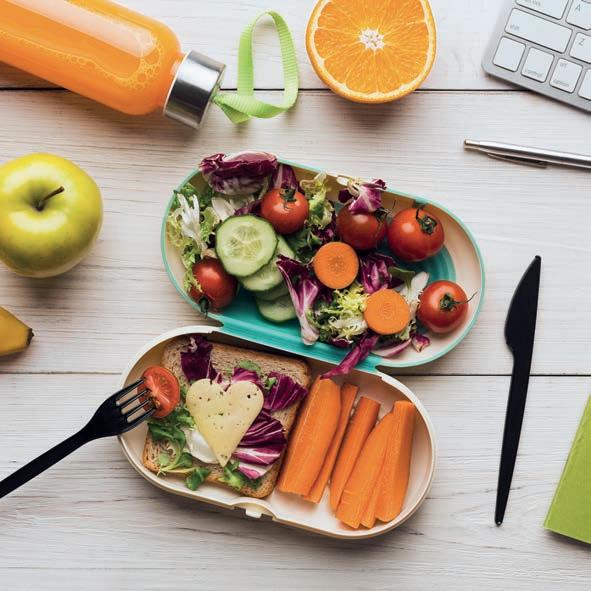
3 minute read
Eat for energy
The nutritional quality of catering provisions can vary drastically between workplaces and even with healthy options available, employees won’t necessarily choose them because of: ● Cost – healthier lunches and snacks can be costly so employers should offer affordable healthy alternatives; ● Lack of awareness – healthy catering is not promoted so employers should create awareness by, for example, displaying nutritional information of dishes at point of purchase or in canteen queues; ● Insufficient employee engagement – employers need to consult with the workforce when changing menus; ● Improper placement – place healthy options instead of high sugar, salt and fat items at checkouts of workplace restaurants or kitchens; and ● Nutritional nudging – display fruit at eye level or provide healthier snacks in communal spaces to encourage healthier choices.
Health tips for employees
Perhaps your employer does not provide workplace catering; you can still make good choices. Taking breaks is beneficial for us, but research shows: ● 52% never leave the office at lunchtime; ● 24% work through their lunch breaks; yet ● 90% of employees who take a proper lunch break feel more refreshed.
To help you eat healthfully and mindfully: 1 Take a break to enjoy a nourishing lunch; 2 Eat away from your desk and devices for better portion control and digestive health; 3 Prepare snacks ahead of time so you have a healthy option in your desk drawer or bag. 9 steps to fight the energy slump
1Get off the blood sugar roller coaster: Snacks combining protein, fibre, healthy fat and carbohydrates slow the sugar release into the bloodstream. For example, wholegrain toast (carbohydrate + fibre) and poached egg (fat + protein) = slow-release energy, and white toast (carbohydrate) and jam (carbohydrate) = fastrelease energy.
2Choose whole grains
and fibre-rich
carbohydrates: Slow-release, fibre-rich carbohydrates provide sustained fuel all day. Opt for wholegrains such as brown rice, brown bread, brown pasta, chickpeas, lentils, beans, quinoa, oats, and sweet potato.
3Protein – consume a little and often: Eat it at each meal – lean meat, fish, low-fat dairy products, eggs, tofu, tempeh, beans, lentils, chickpeas, nuts and seeds.
4Avoid the lunch coma: Eating too much can lead to a post-lunch slump. Be mindful of portion size, especially with carbohydrates and fats. Eat a nourishing snack later if hungry. 53pm snack premeditation: Avoid sugar cravings by having healthy snacks to hand. Choose fresh fruit with a small amount of healthy fats such as apple (sugar) dipped in a little nut butter (healthy fat), or a banana (sugar) with unsweetened yoghurt (fat). Other options include roasted peas, hummus and crudités, boiled eggs, nuts and seeds.
6Stay hydrated: Dehydration leads to low energy, headaches and poor mood and concentration. The average adult requires 1.5 to two litres of fluid a day, however, you can monitor your hydration status by checking the colour of your urine, which should be a pale straw colour or clear. If you struggle with plain water, infuse water overnight with fresh berries, ginger, lemon or mint, or choose fruit and herbal teas.
7Maximise matcha green tea: L-Theanine, found in matcha green tea, helps with relaxed alertness and clarity. Think of it as jitter-free coffee (matcha has a little caffeine).
8Check your nutrients: A simple blood test with your GP can give insight into your nutrient status on iron (red meat, fish, beans, lentils, spinach, tofu, dried apricots and dates), Vitamin B12 (meat, fish, eggs, fortified breakfast cereals, yeast extracts) and vitamin D.
NUTRITION
Employees consume about 60% of their daily food while at the workplace so they should choose to eat healthily, says London nutritionist Lily Sou er in this primer on workplace nutrition
LILY SOUTTER is a corporate wellness nutritionist based in London 9Stay active,
reduce
stress: Movement can jolt us out of our lethargic state. Take a quick power walk around the block or try a walking meeting.










